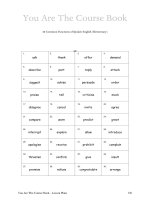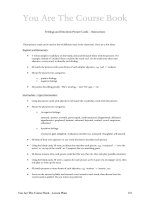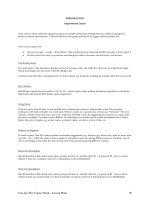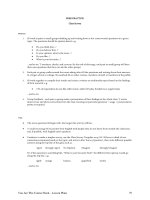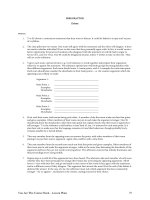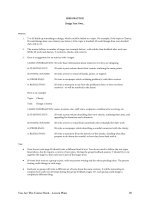yatcb lesson plans debate
Bạn đang xem bản rút gọn của tài liệu. Xem và tải ngay bản đầy đủ của tài liệu tại đây (48.16 KB, 2 trang )
FREE PRACTICE
Debate
Method:
1.
T or SS choose a contentious statement that they want to discuss. It could be linked to a topic and/or part
of a syllabus.
2.
The class splits into two teams. One team will agree with the statement and the other will disagree. It does
not matter whether individual SS are on the team that they personally agree with. In fact, it would create a
better opportunity for practice if students who disagreed with the statement in real life had to argue in
favour of it, and vice versa. One SS could be designated neutral, unless T wishes to take on this role. They
will act as the arbitrator.
3.
T gives each team a period of time (e.g. 10-20 minutes) to work together and prepare their arguments
either for or against the statement. The arbitrator spends time with both groups becoming familiar with
their different arguments. Each team should write 3-4 main points, with 2-3 examples for each main point.
Each team should also consider the drawbacks to their main points – i.e. the counter-argument which the
opposing team is likely to make:
Argument 1:
___________________________________
Main Point 1:
___________________________________
Examples: ___________________________________
Drawbacks: ___________________________________
Main Point 2:
___________________________________
Examples: ___________________________________
Drawbacks: ___________________________________
Main Point 3:
___________________________________
Examples: ___________________________________
Drawbacks: ___________________________________
4.
SS sit with their team, both teams facing each other. A member of the first team reads out their first point,
and gives examples. Other members of their team can join in and make the argument stronger. One SS
should talk about the drawbacks to their first main point but explain clearly why their team’s argument is
still stronger. T or the arbitrator could enforce a time limit of, say, 3-4 minutes for each main point. It is
also their role to make sure that the language remains civil and that behaviour, though probably lively,
remains suitable for a formal debate.
5.
Then any member from the opposing team can answer the point, with other members of their team
joining in to put their team’s argument. Again, this could be with a time limit.
6.
Then one member from the second team reads out their first point and gives examples. Other members of
their team join in and make the argument stronger, while at the same time discussing the drawbacks of the
argument and how they are not worth worrying about. The arbitrator ensures that nobody dominates and
that proceedings move along swiftly.
7.
Repeat steps 4-6 until all of the arguments have been heard. The arbitrator asks each member of each team
whether they have been persuaded to change their mind, due to hearing the opposing arguments. All SS
have to ‘vote with their feet’ and go and stand in one corner of the room if they agree with the statement,
and in a different corner if they disagree. The argument that attracts the most SS at the end of the debate is
declared the winner. In the case of a tie, the arbitrator must rule which argument has been consistently
stronger – for or against – and declare it the winner, stating reasons for their choice.
You Are The Course Book – Lesson Plans
75
8.
Group feedback: T asks SS for their thoughts and feelings about doing this activity. Is there anything they
would do differently another time? How did SS feel if they had to argue for something that they personally
disagreed with? What was it like to be the arbitrator? And so on.
Tips:
•
SS could write up their arguments for homework, contrasting them (if possible) with their own personal
opinion of the statement.
•
The role of the arbitrator is important for maintaining order and a logical way through the activity. If T
chooses a SS to take this role, it will leave them free to monitor, check, and correct. In addition, it gives a
SS the opportunity to practise their English in an important role, rather than T doing it, who is not there to
practise their English. T can ‘disappear’ into the background. T should choose somebody fairly mature and
independent, who is not too bothered what their peers think of them.
•
T could give time for SS to research their arguments; they could use the library and/or Internet to find
relevant statistics, information, and quotations that could make their points even stronger.
You Are The Course Book – Lesson Plans
76
